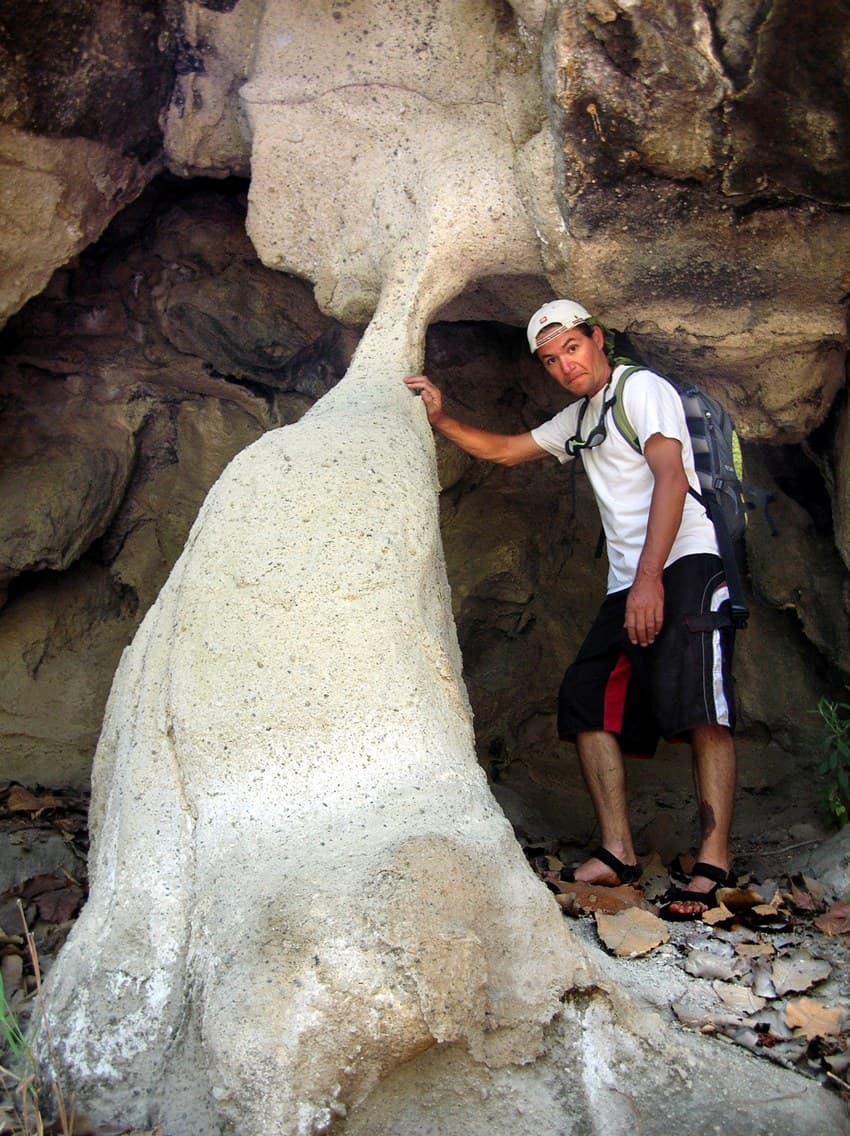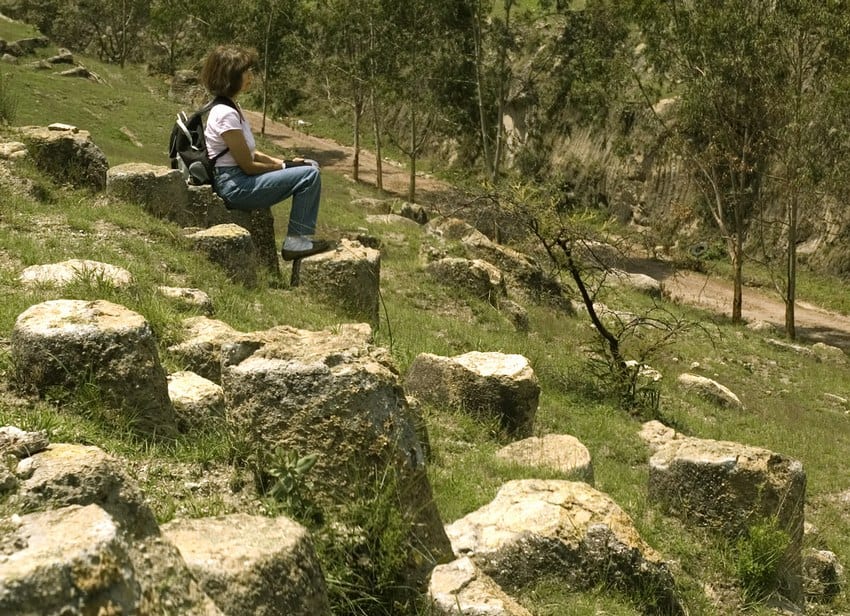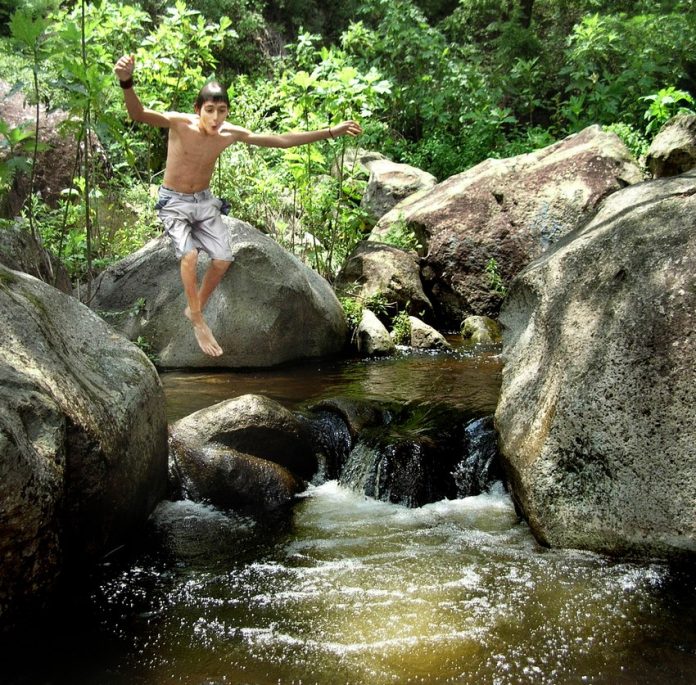Tala is a small town located 30 kilometers due west of Guadalajara, best known these days for its large, government-operated sugar refinery. Two thousand years ago, however, Tala was a large metropolis with a population of some 60,000 inhabitants: the people who constructed the famed Guachimontones, or “circular pyramids,” whose ruins dot hilltops all over western Mexico.
Perhaps those pyramid makers decided to settle in Tala because adjacent to it lies a fairyland of pine and oak trees, bizarre volcanic rocks and clean, ice-cold rivers. In recent times, a local entrepreneur was charmed by the strange beauty of this area and decided to create a housing development there, which he named Villa Felicidad, or Happiness Villa.
The rocks of Villa Felicidad come in a wonderful variety of fantastic shapes. This is a place where you can let your imagination run wild. You’ll see rocks that look like long, meandering walls; stairs leading nowhere; elephants; Easter-Island-type giant heads; the Cookie Monster — you name it.
Felicidad, of course, means happiness, and this is indeed a happy place for naturalists but not for the people who bought land here years ago, since a good number of them lost their shirts — along with their money — when the developer of the fraccionamiento (neighborhood) ended up in jail after allegedly misspending the funds he had collected.
One Sunday, as we drove through Villa Felicidad, we came upon the present-day owner of the land, Hugo Castellanos. Sitting on his motorcycle on the side of the road, he would chat with the drivers of each carful of visitors that came along, always ending with, “… and remember not to leave any garbage!”

Castellano’s efforts seem to have paid off because Villa Felicidad is remarkably clean considering its proximity to a town.
The great variety of curiously shaped rocks at Villa Felicidad is probably due to the result of ancient pyroclastic flows blanketing an area of lakes and rivers. Among the variety of rocks here are many that resemble stone columns, which experts say were created when steam bubbled up through the fallen tephra. These particular phenomena are called fossil fumaroles, and you can see them all over Villa Felicidad, where they very much resemble tree stumps made of stone, which for years we referred to as “fairy footstools.”
Never did we suspect that those “stumps” were merely the tips of very long, perfectly straight columns of rock until one day we found a road cut that exposed what was hidden beneath the surface.
The process by which these fossil fumaroles, or pipes, are formed is well-known thanks to an eruption followed by a volcanic ash flow that took place in 1912 in what is now known as The Valley of Ten Thousand Smokes in Alaska’s Katmai National Park.
The “smokes” were actually steam. Some theorize that the rising bubbles carry away finer particles of ash with the result that — thousands of years later — that column, now compacted into solid rock, is harder than the material surrounding it.
On one of our many visits to this fascinating area, we discovered a hidden-away swimming hole and waterfall after following a river known as El Río Zarco. The word zarco, by the way, means something like cloudy, referring to mineral content in the water of a stream or pool, but in no way suggests that the water is unfit to drink.

During most of its route, the Río Zarco runs along the bottom of steep slopes. We followed it for hours, and all along our route we kept bumping into strange rock formations: “This one resembles the mouth of a snake; that one is a frog … and this looks just like a man-made wall.”
We even found a few perfectly rectangular “stone blocks,” but close examination always revealed that what we were looking at was nature’s handiwork.
After an hour’s walk, we reached a lookout point from which we could see far below us a turquoise pool of water fed by a frothy white waterfall. Hugo’s Heavenly Pool, we named it. We clambered down and soon found ourselves on a little beach.
The mini-lagoon turned out to be a lot bigger and deeper than it appears from above, and the water much colder than I would have guessed. This glowing green pool even comes with a little sandy beach where you can lie back and contemplate the funny-looking rocks looking down on you.
While few people know of El Río Zarco, there is another cool, clean and much bigger river at the east end of Villa Felicidad: El Río de las Ánimas is born deep inside the Primavera Forest, and after it skirts Tala, it flows into nearby Lake La Vega. I used to call it “The River of Souls” until I learned that there are two words for soul in Spanish: alma and ánima.
The former refers to the souls of living persons as well as those who have made it to heaven or that other place. An ánima, however, has not yet reached its final destination. This word covers the souls in Purgatory as well as those said to wander about cemeteries and haunted houses.

So, I am now calling it The River of Ghosts, a name it might possibly have received long ago by someone who noticed the above-mentioned bizarre rocks and fossil fumaroles found along its banks.
If you head upstream, you’ll quickly come to a spring where clean, warm water gushes out of the hillside and cascades over a small waterfall into the river. Three hundred meters upstream from here, there’s a small, natural bathing pool next to a wide meadow perfect for camping, at the edge of which you’ll find several fossil fumaroles of extraordinary size.
We measured one at 1.2 meters in diameter, surely one of the bigger examples of such formations to be found anywhere in the world.
Nowadays a four-lane highway bisects Villa Felicidad. This is the new bypass around the city of Guadalajara, locally known as the megalibramiento. At first, I feared this toll road would cut off access to Villa Felicidad, but they actually built an overpass just for the rough dirt road leading from Tala to the River of Ghosts.
To get to a parking spot from which you can walk to Río de las Ánimas, you need to follow two steps. First ask Google Maps to take you to “Calle Luis Rojas, Tala, Jalisco.” Once you are there, ask for “M84V+25 Tala, Jalisco.”
Google Maps will show you two routes; one goes straight east, and the other makes a big northerly loop. I have found this loop impossible to follow, so take the other choice: keep going east on Luis Rojas, and you will soon be crossing Villa Felicidad.

The road is rough but you don’t need four-wheel drive. When you reach the parking spot, walk downhill, heading east again, and after 400 meters you will reach the Ghostly River.
The writer has lived near Guadalajara, Jalisco, for 31 years and is the author of A Guide to West Mexico’s Guachimontones and Surrounding Area and co-author of Outdoors in Western Mexico. More of his writing can be found on his website.
[soliloquy id="137373"]
